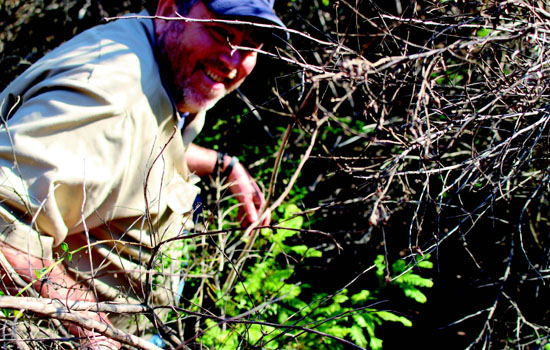|
|
Published January 14th, 2015
|
The Man Who Plants Trees
|
| Ranger Mark Silva is on a mission
|
| By Chris Lavin |
 |
| Photo Chris Lavin |
Once upon a time, a long, long time ago, there emerged a valley - several valleys actually - that came to line the watershed that flows down, then sucks in the rainwater and fog that seeps into the aquifers, collects into our dams, and provides us with what ultimately comes out of our taps. It's our watershed, and the East Bay Municipal Utility District is in charge of it.
 "People don't realize we drink this," said Mark Silva, deftly stepping out of his EBMUD truck and motioning toward the Upper San Pablo Reservoir at the Valle Vista Staging Area in Moraga. Silva is a large person with a big vision. He wears a Fitbit training monitor on his wrist. His daughter gave it to him to make sure he stays in shape. "I get more than 10,000 steps every day," he said, indicating the monitor's goal. "I'm a big guy, but I'm in good shape." It's a tiny symbol indicating what Silva does practically every day, because the bigger picture is, he counts his steps in trees.
"People don't realize we drink this," said Mark Silva, deftly stepping out of his EBMUD truck and motioning toward the Upper San Pablo Reservoir at the Valle Vista Staging Area in Moraga. Silva is a large person with a big vision. He wears a Fitbit training monitor on his wrist. His daughter gave it to him to make sure he stays in shape. "I get more than 10,000 steps every day," he said, indicating the monitor's goal. "I'm a big guy, but I'm in good shape." It's a tiny symbol indicating what Silva does practically every day, because the bigger picture is, he counts his steps in trees.
 Beware the person who doubts this, following him into the bush. Silva has a mission. And that mission is to put back the redwood trees that were all sawed down and hauled out just about 100 years ago, in the early 1900s and before, planting them back into the bramble and thimble that has become an establishment of his hacked down, replanted watershed. The Monterey pines are gradually getting taken out. As EBMUD ranger and naturalist Matt Sporleder said, "Someone in the 1950s thought that was a good idea" to plant those Monterey pines. Think again, he says.
Beware the person who doubts this, following him into the bush. Silva has a mission. And that mission is to put back the redwood trees that were all sawed down and hauled out just about 100 years ago, in the early 1900s and before, planting them back into the bramble and thimble that has become an establishment of his hacked down, replanted watershed. The Monterey pines are gradually getting taken out. As EBMUD ranger and naturalist Matt Sporleder said, "Someone in the 1950s thought that was a good idea" to plant those Monterey pines. Think again, he says.
 "Those trees are dying and they only have about a 50-year lifespan," Sporleder said of the pines. "Mark Silva has a vision for that area." To that end, Silva has taken it upon himself, for the past 20 years, to collect endemic seeds, germinate them in his back yard in Castro Valley, nurture the seedlings at the EBMUD yard in Orinda, then transplant the trees back into the watershed. He even goes out in the spring to the creeks and nets the pools of fallen redwood seeds that have blown down, dries them, then plants them scatter-style in his nursery to see what sprouts.
"Those trees are dying and they only have about a 50-year lifespan," Sporleder said of the pines. "Mark Silva has a vision for that area." To that end, Silva has taken it upon himself, for the past 20 years, to collect endemic seeds, germinate them in his back yard in Castro Valley, nurture the seedlings at the EBMUD yard in Orinda, then transplant the trees back into the watershed. He even goes out in the spring to the creeks and nets the pools of fallen redwood seeds that have blown down, dries them, then plants them scatter-style in his nursery to see what sprouts.
 "I really don't know what I'm doing," he says modestly. But then again - it's at least 400 trees later. For instance, on a recent hike through the watershed, a woman leading a Welsh pony called out to Silva: "Are you checking on your trees?" Silva muffled a yep. "They're doing good!" she yelped.
"I really don't know what I'm doing," he says modestly. But then again - it's at least 400 trees later. For instance, on a recent hike through the watershed, a woman leading a Welsh pony called out to Silva: "Are you checking on your trees?" Silva muffled a yep. "They're doing good!" she yelped.
 "I've watched him," said pony owner Karen Bottiani of Lafayette, contacted later by phone. "He's a really good guy. What he is doing is going to completely change that landscape. It's going to put it back where it used to be. This place is going to look completely different in 50 years." More like it used to look, she said. She has seen him in dry seasons carrying 5-gallon jugs of water to redwood seedlings that need that first jolt for the first couple of years. "If they get water in that first year, that's what counts," Bottiani said. "He's making sure those trees get that."
"I've watched him," said pony owner Karen Bottiani of Lafayette, contacted later by phone. "He's a really good guy. What he is doing is going to completely change that landscape. It's going to put it back where it used to be. This place is going to look completely different in 50 years." More like it used to look, she said. She has seen him in dry seasons carrying 5-gallon jugs of water to redwood seedlings that need that first jolt for the first couple of years. "If they get water in that first year, that's what counts," Bottiani said. "He's making sure those trees get that."
 Silva's goal is simple: Replace the non-native Monterey pine with the more fire resistant native coast redwood. He not only wants to protect obstruction of the public road by falling pines, but to protect the watershed from unnecessary runoff into the actual water by having sustainable trees that don't fall down in a big wind storm. To that end, in 2003 Silva found what he calls the "glory hole," something a public relations savvy reporter told him was a bad name for a hole. Silva did not know what she meant. Instead, he espoused on how he had found a hundred, no hundreds, of saplings in an area that he pillaged for seedlings and, while leaving plenty, dispersed them throughout the watershed.
Silva's goal is simple: Replace the non-native Monterey pine with the more fire resistant native coast redwood. He not only wants to protect obstruction of the public road by falling pines, but to protect the watershed from unnecessary runoff into the actual water by having sustainable trees that don't fall down in a big wind storm. To that end, in 2003 Silva found what he calls the "glory hole," something a public relations savvy reporter told him was a bad name for a hole. Silva did not know what she meant. Instead, he espoused on how he had found a hundred, no hundreds, of saplings in an area that he pillaged for seedlings and, while leaving plenty, dispersed them throughout the watershed.
 "Here's one!" shouted Silva, diving into a pile of poison oak. "I didn't know this one made it." He subsequently began to tear down the broom overshadowing the pre-pubescent tree, shining light on its pale green branches. "Here you go!" Silva said, but he swears he doesn't talk to the trees.
"Here's one!" shouted Silva, diving into a pile of poison oak. "I didn't know this one made it." He subsequently began to tear down the broom overshadowing the pre-pubescent tree, shining light on its pale green branches. "Here you go!" Silva said, but he swears he doesn't talk to the trees.
 "I'm not kidding," said Sporleder, who is taking out a Girl Scout troop later this month to plant 20 more redwood trees from Silva's nursery. "He goes out when it's raining hard and just stands there. He wants to know where the water is going. He wants to see where the erosion is happening. He looks and sees what needs to be done to keep the water clean and the soil in place."
"I'm not kidding," said Sporleder, who is taking out a Girl Scout troop later this month to plant 20 more redwood trees from Silva's nursery. "He goes out when it's raining hard and just stands there. He wants to know where the water is going. He wants to see where the erosion is happening. He looks and sees what needs to be done to keep the water clean and the soil in place."
 "Then he plants trees," Sporleder said.
"Then he plants trees," Sporleder said.
 On a recent day at the Valle Vista lot, several acorn woodpeckers flew in to take their spots on remaining Monterey pine snags. What about them?
On a recent day at the Valle Vista lot, several acorn woodpeckers flew in to take their spots on remaining Monterey pine snags. What about them?
 "Oh! We kept those snags there just for that reason," Silva said. "The woodpeckers like them." He calmly looked down at his wrist, and it wasn't' even 10 a.m. "Hey! I got 10,000 steps!" (On his Fitbit device.) "Now let's go see some trees."
"Oh! We kept those snags there just for that reason," Silva said. "The woodpeckers like them." He calmly looked down at his wrist, and it wasn't' even 10 a.m. "Hey! I got 10,000 steps!" (On his Fitbit device.) "Now let's go see some trees."

|
|
|
|
|
|
|
|
|
| |
|
|
|
|




